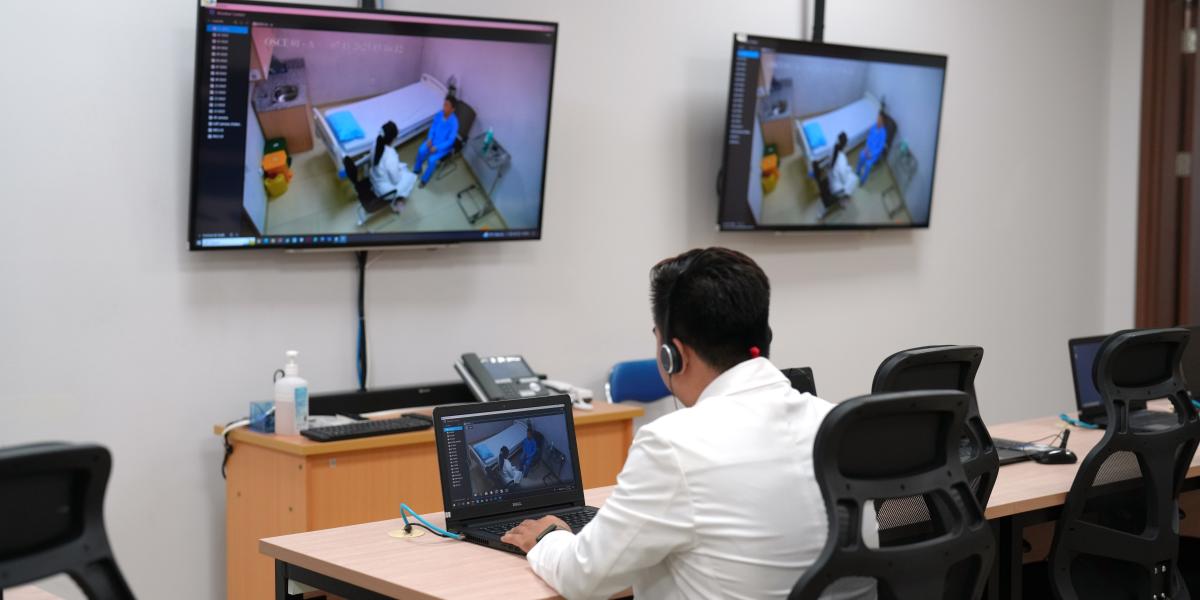How USAID is Modernizing Medical Education in Vietnam
The medical student sits, listens, and takes notes as the patient describes her symptoms. They are across from one another in what looks like a doctors consultation office, but this is no ordinary consultation room. High on the walls are recording equipment capturing everything the student and patient say and do, relaying it down the hall to a viewing room where faculty members watch. No, this is not a police sting operation, but rather a classroom—just one of the innovative teaching techniques being used at the University of Medicine and Pharmacy at Ho Chi Minh City (UMP). With USAID support, the school recently completed reforming its undergraduate medical curriculum to a competency-based one, with a curriculum that is student-centered, prioritizes active learning over passive listening, and is responsive to evolving patient and societal needs.


At the forefront of this change is Dr. Vuong Thi Ngoc Lan, Dean of the Faculty of Medicine and Head of the Department of Obstetrics and Gynecology. Dr. Lan has been involved in the medical world since she was a young child. Both her parents studied at UMP and her love of Obstetrics came from going to work with her mother, where she would watch her work with patients. This early exposure to the medical world has instilled in her a deep passion for treating patients, leading her to be one of Vietnam’s most prominent doctors, even being on the team that performed the first in vitro procedure in the country.
With new technological advancements in health care and unpredictable health threats, medical education in Vietnam needs to adapt and reform to ensure that health care providers can deliver high-quality care, responsive to the ever-evolving health needs. UMP began this journey in 2016 when it, along with five other Vietnamese medical universities, joined the USAID-funded IMPACT-MED Alliance, implemented by Harvard Medical School. This alliance brings together a diverse group of Vietnamese universities and public and private sector partners to collaborate on building a strong and effective health workforce in Vietnam, capable of responding to the needs of the 21st century.
“Students feel like they are seeing patients in a real setting. Sometimes they even forget they are being observed,” says Dr. Lan about the practice consultation room. The school places a high value on this style of practical learning, allowing students to see real patients in their second year, a full year earlier than before. In the past, class consisted of teachers standing at a lectern delivering lectures to students. Now, students access lectures online prior to class and class time is spent in small groups discussing how the content applies to actual clinical cases. At UMP, health care is taught as an integrated practice. For example, a course on reproductive health draws on members of the anatomy, pathology, and embryology faculties. Finally, there is a new interest in having feedback from both faculty and students, so that the curriculum can adapt and evolve with the times.
“My door is always open. Students can stop in and ask questions or for advice anytime,” Dr. Lan remarks on the importance of feedback.

Between 2016 and 2022, USAID supported the reform of undergraduate medical education at five medical universities, revamping the curriculum from a predominately theory-based, knowledge-acquisition approach to a holistic, competency-based program that integrates medical knowledge, clinical skills, and professional physician standards. Building on this success, the Alliance expanded this work to an additional five universities in 2022.
The hard work that they put into the reform is paying off. In November 2022, UMP graduated the first class of 372 students who studied under the new curriculum with 97% of graduates finding employment. The school’s success has started a trend in other medical schools to also review their own curriculums and modernize them. UMP is directly mentoring Can Tho University of Medicine and Pharmacy, the leading medical school in the Mekong Delta, to reform its curriculum. For Dr. Lan, it is her and the UMP’s responsibility to support other schools.
“We received support and now we need to give. We assess their needs and resources and then together we are discussing what interventions are needed to reform the Can Tho curriculum.”


By 2026, with USAID support, ten of Vietnam’s leading medical universities—representing one-third of all medical universities in the country—will be implementing a reformed six-year undergraduate medical education curriculum for general medical doctors, and six will be implementing reformed medical residency programs on general surgery and internal medicine, benefiting a combined 18,000 medical students and residents. More than 4,000 faculty will be trained in new educational methods. “The curriculum brings a new active generation of doctors. No one can predict what will come; we hope that our doctors can adapt to new situations and importantly, that they are willing to adapt.” Dr. Lan continues, “We encourage the students to be lifelong learners because information is changing quickly. We teach them how to learn.”
ABOUT THE AUTHOR: Benjamin Ilka is a storyteller and visual media specialist at USAID’s Mission in Vietnam.


